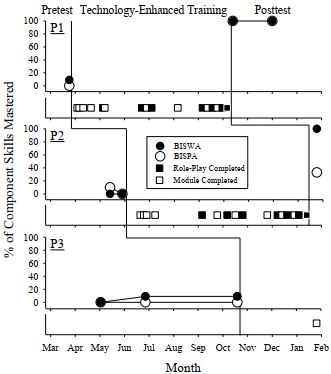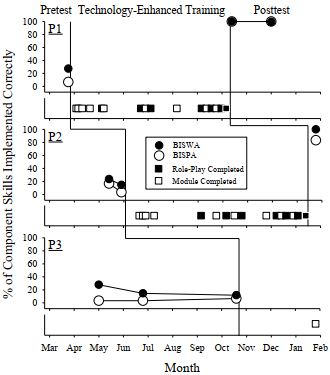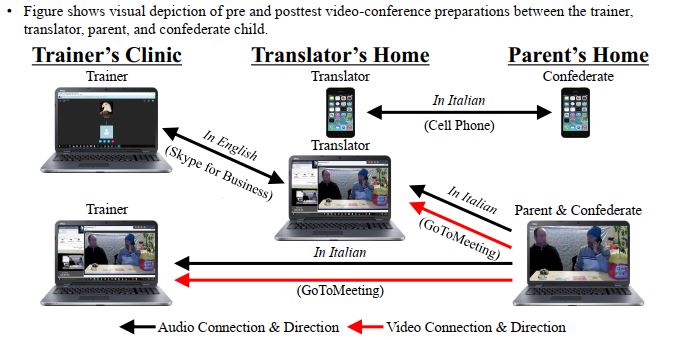Further Analysis of a Web-Based Program for Training Italian-Speaking Parents to Implement Early Intensive Behavioral Intervention
Andrew P. Blowers, Megan E. Vosters, Kevin C. Luczynski, Wayne W. Fisher, and Ciobha A. Mckeown
University of Nebraska Medical Center’s Munroe-Meyer Institute
Alessandro Dibari, Daniele Rizzi, and Erica Scandurra
Associazione Abruzzese Liberi Bambini dall’Autismo
*This research was supported by Grant Number AR100184 from the Autism Research Program, which is a component of the Congressionally Directed Medical Research Programs within the Department of Defense
Introduction
A major barrier to accessing quality services for children with an autism spectrum disorder (ASD) is the shortage of therapists. One part of the solution involves training parents to either function as behaviorchange agents or facilitate generalization of skills taught by credentialed behavior analysts. However, this approach does not benefit families residing in remote geographical locations (e.g., rural communities) if they do not live near service providers.
A viable approach to increasing accessibility to parent-training services is to leverage videoconference software with virtual-private networks to deliver training over the internet (e.g., Fisher et al., 2014; Fisher et al., in preparation; Suess et al., 2014; Wacker et al., 2013). Fisher et al. (2014) showed that a comprehensive virtual-training program, which included e-learning modules, quizzes, and role-plays with feedback, was effective in teaching adults to implement a variety of behavior-change procedures compared to a control group. Fisher et al. (in preparation) recently extended the technology-enhanced training curriculum to parents.
In response, we sought to replicate and extend the results of Fisher et al. (in preparation) by evaluatingthe effects of the 20-hour virtual-training program which included e-learning modules and virtual behavioral skills training delivered by English-speaking board certified behavior analysts to Italianspeaking parents mediated by a translator on teaching parents to implement EIBI programs. Positive results would provide support for the utility of using translators in mediating virtual-training to nonEnglish-speaking parents.

Method
Participants, Setting, and Materials
- We identified three Italian-speaking parents of children with an ASD, who reside in Italy and had no prior training in applied behavior analysis (ABA)
- Each parent recruited an Italian-speaking friend, who acted as a child with an ASD (hereafter referred to as a confederate child).
- Three bilingual Italian- and English-speaking adults who are board certified behavior analysts (hereafter referred to as a translator).
- Two English-speaking adults who are board certified behavior analysts (hereafter referred to as a trainer).
- We conducted all sessions virtually using synchronous video conference software which entailed audio and video functions with a virtual-private network between the parent’s, translator’s, and trainer’s computers.
- Technological materials included three to four laptop computers (one to two for the trainer, one for the translator, and one for the parents), two cell phones, Bluetooth headsets, and nine e-learning modules translated from English to Italian.
- Non-technological materials included picture cards and various toys that could be used during free play (e.g., Legos, foam ball, blocks, and toy cars).
- We used GoToMeeting and Skype for video and audio conferencing. We used Echo360 Personal Capture to record the screen of the laptop from which the dependent measures were subsequently scored .
Dependent Variables and Interobserver Agreement
- We used the Behavioral Implementation of Skills for Work Activities (BISWA) and the Behavioral Implementation of Skills for Play Activities (BISPA) (Fisher et al., 2014). Both include competency-based measures with direct observation of the parents implementing ABA procedures in discrete-trial (BISWA) and play-based (BISPA) formats.
- The BISWA included 36 trials during which we assessed parents’ accuracy in implementing 11 component skills: (a) gains confederate child’s attention, (b) delivers clear instruction, (c) instruction phrased as a demand, (d) instruction is behavior specific, (e) waits 5 s for confederate child’s response, (f) delivers descriptive praise following a correct response, (g) delivers reinforcement following a correct response, (h) ignores problem behavior, (i) represents instruction following an error, (j) delivers model prompt, and (k) delivers physical prompt.
- The BISPA included 20 trials during which we assessed parents’ accuracy in implementing 3 component skills: (a) delivers descriptive praise following a correct response, (b) delivers reinforcement following a correct response, and (c) ignores problem behavior.
- We calculated interobserver agreement by having two independent observers collect data on parent’s responses for 30% of pre and posttest sessions. Next, we divided the total number of trials on which the observers agreed by the total number of trials scored and converted that number into a percentage. Interobserver agreement was 89% and 97% for the BISWA and BISPA, respectively.
Experimental Design We demonstrated functional control using a concurrent multiple-baseline design across parents.


Method
Pretest and Posttest
- We conducted the BISWA and BISPA with the parents without providing feedback in pre and posttests. Prior to starting the BISWA, the trainer informed the parent that the goal was to teach the confederate child to touch the correct picture based on its spoken name (e.g., “Touch horse.”). Prior to starting the BISPA, the trainer instructed the parent to play with the confederate child as they would with their child with ASD.
- The trainer used GoToMeeting’s audio and video to connect with the parent, confederate child, and translator. The trainer used Skype for Business’s audio to connect with the translator. The translator used cell phone audio to connect with the confederate child
Technology-Enhanced Training
E-Learning Modules- Nine e-learning modules covered the following topics: (a) ethics, (b) preference assessments, (c) verbal behavior, (d) response prompts, (e) natural environment teaching, (f) compliance, (g) preventing problem behavior, (h) putting it together one, and (i) putting it together two.
- Each e-learning module took approximately 30 to 60 min to complete.
- Before progressing from one module to the next, parents had to obtain a score of 80% correct or better on the corresponding 10 multiple-choice question quiz. For seven modules, a role-play was conducted in the family’s home following the multiple-choice quiz.
Role-Plays
- The technology and trial setup of the role-plays were the same as described for pre and posttest, except that the trainer instructed parents to implement the target skill based on the content from the e-learning module.
- Each role-play included 20 trials, which lasted approximately 60 min to 90 min, and the trainer provided descriptive feedback following correct and incorrect responses. Parents progressed to the next module only after implementing all component skills correctly across the 20 trials of a given role-play. For example, if the parent did not implement a prompt procedure correctly on the first trial, the trainer provided feedback and repeated that trial until the parent implemented the prompt procedure correctly
Results and Discussion
For component skills mastered, P1 and P2 improved from an average of 3% and 0% during pretest to an average of 100% and 78% during posttest on the BISWA and BISPA, respectively. For component skills implemented correctly, P1 and P2 improved from an average of 22% and 9% during pretest to an average of 100% and 94% during posttest for the BISWA and BISPA, respectively. These increases occurred only after the parent experienced the technology-enhanced training.
These results systematically extend those reported by Fisher et al. (in preparation) and advance the parent-training literature by showing that (a) using a translator mitigates language barriers between English-speaking BCBAs and non-English-speaking parents and (b) parents can access virtual-training despite living in a different continent than the trainer.
Future research directions include replicating these procedures using translators without training in ABA, using translator programs or devices such as the Waverly Labs Pilot translating earpiece, using a pyramidal model to train-the-trainer, and collecting generalization measures on the skills parents acquired from the technology-enhanced training to their child with ASD.
